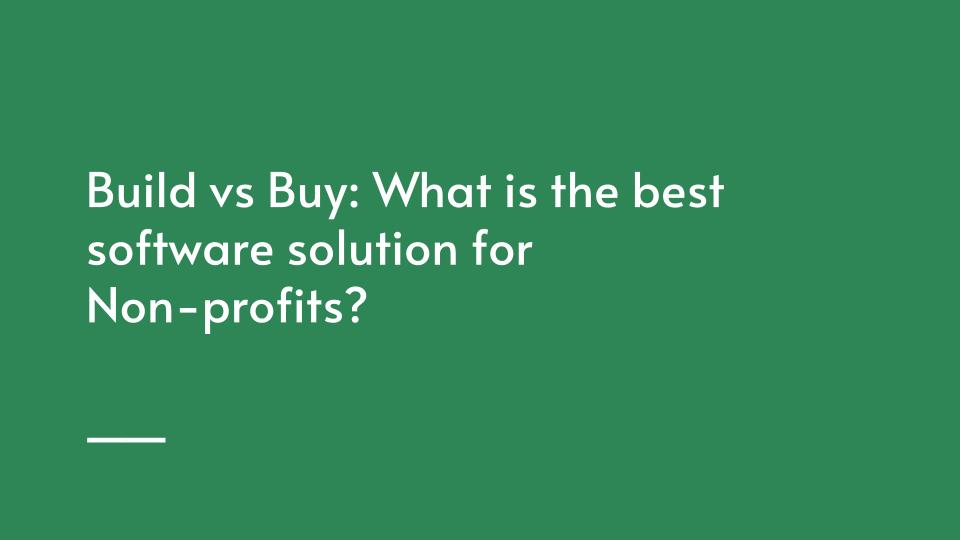
"Software is eating the world"
– Marc Andreessen, co-author of Mosaic, the first widely used web browser with a graphical user interface; co-founder of Netscape; and co-founder and general partner of Silicon Valley venture capital firm Andreessen Horowitz
In today's world, tech is ubiquitous, and software is the engine that powers it. From streamlining operations to enhancing user experiences, software is a non-negotiable for non-profits. However, the question of whether to build or buy software is a critical one. This article explores the pros and cons of both approaches and offers a hybrid solution that can help non-profits thrive.
Understanding "Build" vs "Buy"
"Build" implies creating bespoke software tailored to your organization's requirements, while "Buy" means acquiring a ready-made software solution from a vendor.
This should not be confused with "Open Source," which refers to software whose source code is publicly available for anyone to use, modify, and share. I will be writing a separate article on Open Source software for non-profits. So stay tuned! :)
Why Build?
The Advantages
- Customization: Craft software that aligns perfectly with your organization's unique programs or services.
- Cost Efficiency in the Long Run: Avoid recurring licensing or subscription fees.
- Full Ownership: Exercise complete control, making alterations as and when required, without any third-party dependence.
- Staying Ahead: In a digitized world, owning your software can provide a competitive edge. However, note that custom development doesn't always fit every organization's needs.
The Flip Side of Building
- Resource Intensive: Demands significant time, expertise, and financial commitment.
- Potential Risks: Delays, budget overshoots, and the responsibility of continual maintenance.
The Case for Buying
The Pros of Purchasing
- Quick Deployment: Implement immediately without waiting for development.
- Reduced Initial Costs: Often cheaper upfront than bespoke solutions.
- Vendor Support: Regular updates and technical assistance come bundled.
The Cons of Purchasing
- Less Flexibility: Potential compromises on features or adaptability.
- Vendor Dependency: Relying heavily on a single provider might pose challenges if you wish to migrate or make substantial modifications later.
The Best of Both? A Hybrid Approach
Considering a blend of custom-built and pre-existing software can sometimes offer the ideal solution, harnessing tailored capabilities with standardized functionalities. For instance, you could build a custom front-end for your website and use a third-party Content Management System (CMS) for the back-end. Or, you could develop a custom application and integrate it with a third-party Customer Relationship Management (CRM) system.
However, this approach can be complex and requires careful planning. You must ensure that the two systems are compatible and can communicate seamlessly. You also need to consider the cost of integration and the potential for future upgrades.
The Bottom Line
When to Build
-
When You Have the Resources: If you have the time, talent, and budget to develop a custom solution, it can be a worthwhile investment.
-
When You Have Unique Requirements: If your needs are highly specific, a bespoke solution can be the best way to go.
When to Buy
-
When You Have Limited Resources: If you lack the time, talent, or budget to develop a custom solution, purchasing can be a viable option.
-
When You Have Generic Requirements: If your needs are relatively straightforward, a pre-existing solution can be a cost-effective choice.
When to Blend
-
When You Have the Resources: If you have the time, talent, and budget to develop a custom solution, but your needs are relatively generic, you could consider a hybrid approach.
-
When You Have Unique Requirements: If your needs are highly specific, but you lack the resources to develop a custom solution, you could consider a hybrid approach.
Making the Call: Build or Buy?
- Crunch the Numbers: Factor in both immediate and future expenses and juxtapose them with the anticipated benefits.
- Assess Technical Capacity: Gauge whether you have the in-house talent to build or if purchasing, with vendor support, is more feasible.
- Engage Stakeholders: Gather insights from staff, board members, and beneficiaries to inform your decision.
Conclusion
While custom software can unlock unprecedented capabilities, it's not always the best option. The decision to build or buy must be based on your organization's unique needs and resources. And, if you're still unsure, a hybrid approach can be a great way to go.
You can also consider a phased approach, starting with a pre-existing solution and then transitioning to a custom one as your organization grows. This can help you test the waters and make a more informed decision.
Success Stories: Non-profits Thriving with Custom Software
- Eco-Advocacy Group: Transitioned from a third-party solution to their in-house software, enhancing their data analysis capability, leading to more efficacious conservation methods.
- Educational Initiative: Moved beyond a generic Learning Management System to a custom-built platform, driving personalized and impactful learning experiences.
- Disaster Relief Organization: Developed their dedicated software, honing their resource coordination and disaster response mechanism.
If you are interested in learning more about how custom software or a hybrid approach can help your non-profit, please reach out. I'd love to help!
